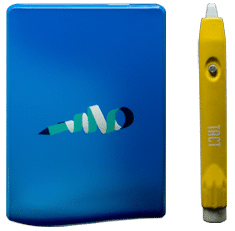
Tact is Unlocking Benefits of Interactive Learning for Special Needs Students.
Inclusive education is a pillar of our society, ensuring that all students, regardless of ability, have equal access to high-quality education. When it comes to students with special needs, interactive learning techniques are critical to their educational development. Educators can create a dynamic and inclusive learning environment that caters to these students’ unique needs by engaging them through interactive methods. In this blog,
we will look at the various advantages of interactive learning for students with special needs and how it can help them succeed in school along with the support of the Tact device that is used as the interactive tool of education. As the device of Tact enables students to interact with the educational content displayed on the screen or any displayed space (up to 150 inches) smartly using the Tact’s pen. And below shows how Tact is unlocking several benefits of interactive learning elements:
-
Enhancing Engagement:
Students are actively involved in the learning process with interactive learning strategies, making it easier for them to grasp and retain information. Interactive learning can be especially beneficial for students with special needs, who frequently require additional support and reinforcement. Group discussions, hands-on experiments, multimedia presentations, and educational games help create an engaging environment that encourages active participation and encourages students to explore concepts enthusiastically.
And therefore Tact’s device is developed to enhance engagement through interactive visual content shared with up to 4 students easily which fosters the element of joy and fun among special needs students.
-
Personalised Instruction:
Every student, including those with special needs, has a unique learning style. Using interactive learning tools, educators can tailor their teaching methods to meet the diverse needs of their students. Teachers can create a more personalized and inclusive learning experience by including a variety of interactive tools and techniques like the Tact device.
Because the device utilization is super easy and students with special needs will adapt to using it in a fast manner achieving the goal of interactive learning. This approach ensures that no student is left behind by providing students with special needs with the appropriate adaptations and modifications to meet their individual needs.
-
Multi-Sensory Approach:
A multi-sensory learning approach that engages multiple senses at the same time benefits many students with special needs. Visual aids, aural signals, tangible activities, and active exercises are examples of interactive learning techniques that allow students to absorb information through various senses. This multisensory stimulation improves memory retention, comprehension, and overall cognitive development, allowing students to process and internalize concepts more effectively. All that can be applied easily through the interactive displayed surface controlled by Tact.
As students can engage with the visual content and are alerted by the notifications that occur according to their activities on the displayed space and feels happy about their achievements.
-
Promoting Social Interaction:
More importantly, Tact the Interactive Device encourages collaboration and social interaction among students. For students with special needs, who may struggle with social skills and forming connections, this aspect of interactive learning is invaluable. Group projects, peer discussions, and cooperative learning activities provide opportunities for students to work together, develop communication skills, and build relationships with their peers that can be easily formed in small teams or groups of four members and proceed with the contest using the tact’s pen simultaneously.
The supportive and inclusive environment created by Tact the interactive device can foster a sense of belonging, leading to increased confidence and social growth.
-
Boosting Confidence and Self-Esteem:
Students with special needs often encounter difficulties that can undermine their self-esteem. Interactive learning activities that emphasize their strengths and abilities aid in the development of their confidence and self-esteem. Students can recognize their potential and feel a sense of accomplishment by actively participating in class discussions, solving problems, and contributing to group activities. This positive reinforcement improves their general well-being and encourages them to participate actively in their education.
Conclusion:
Interactive learning provides a powerful framework for educators to unlock the potential of students with special needs. By employing engaging and inclusive teaching strategies, students can benefit from enhanced engagement, differentiated instruction, multi-sensory experiences, social interaction, and increased confidence.
The implementation of interactive learning techniques requires collaboration between educators, administrators, and parents to create an environment that supports and nurtures the diverse needs of students with special needs. Together, we can ensure that every student receives the education they deserve, enabling them to thrive and reach their full potential.
Tact device is one of the most important tools that foster the interactive learning process for being easy to use, focus on engaging with visual content, highly integrated with all computer systems with its application, and invented in a way that doesn’t allow any technical issues can occur during the learning process. To learn more about Tact, feel free to reach our contact center or visit our website